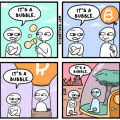Bitcoin — it is a new social and economic institution. It's so different from our existing onesinstitutions that we should relate to himskeptical and ask as many complex, acute questions as possible before entrusting him any economic value. Answers to some questions will come only with time, but this does not mean that we cannot build our theories or systems. One such system that allowed me to better understand Bitcoin is the theory of social contract.
</p>First, fiat money — this is the resultsocial contract: people transferred control over the money supply and all functions of money to the state. The state, in turn, uses this power to manage the economy, redistribute wealth and fight crime. But what many don't realize is that Bitcoin also works through a social contract.
Social stratum and its rules — this is the heart of Bitcoin.
And this social contract theory can answersome important questions: Why did Bitcoin come into being? Who determined its properties? Who runs it today? Can a critical bug «kill» Bitcoin?
Theory of Social Contract
Social contract theory begins withthought experiment. Imagine a hypothetical state of affairs, full of violence, in which people find it unbearable to live. Driven by a desire to improve their situation, people gather and collectively decide to empower Leviathan — sovereign government — for him to protect them. Everyone gives up some of their personal freedom (you know, the right to steal, kill, rob caravans, etc.), while Leviathan is given the power to make laws, enforce them, and protect people from violence.
But this theory is not limited to relationshipsbetween people and the state. We can apply the same thought experiment to economics. If a sufficient number of people are dissatisfied with the barter system, they can jointly agree to use money, loans, and whatever else to improve the quality of their trading operations.
The process of the appearance of money or loans occursunnoticed. Every person asks himself the question what result he would like to get and how this can be achieved. If a large number of people in a society desire the same outcome, we can call that outcome a «focal point», or social contract.
Money as a social contract
Throughout history, governments that have controlledmoney, abused their power in a variety of ways: they froze accounts, prohibited certain individuals and groups from making transactions, printed large quantities of money and inflated the money supply — which sometimes led to hyperinflation.
When governments crossed the lineabusing their power, people lost confidence in the social contract that endowed the government with this power. They returned to an agreement that retained most of the advantages (the existence of a single medium of exchange, measure of value and unit of account) without the worst problems (abuse of government): commodity money.
Money provides an important lesson: the larger and the more valuable a social institution becomes, the more it attracts those who want to gain control over it.
However, a new commodity money contractturned out to be just as unstable, and that was the problem. Let's take, for example, the gold standard. Gold alone was too inconvenient to share, move and store. Because people quickly invented the add-in and traded with paper money representing gold, while physically the gold did not move anywhere. Because paper money is easy to produce, a need has emerged for a reliable central authority to monitor the money supply. It is from here that governments took a small step to separate the value of paper money from the goods providing them, as a result of which fiat money was re-created.
A valuable lesson is hidden here: you can agree that you are in a terrible situation, and you can agree to change it, but the resulting social contract is strong only as long as it is trustworthy. Without a stable institution that implements it, the contract loses trust from people and breaks up.
Bitcoin Rules
When Satoshi Nakamoto invented Bitcoin, he didn’tcame up with a new social contract. Satoshi did something else: he used technology to solve many old problems and implemented the old social contract in a new, better way. He established the following rules:
1) Only the owner of the token can produce a signature for its use (confiscation resistance).
2) Anyone can transact and store bitcoins without outside permission (censorship resistance).
3) There will be a total of 21 million Bitcoins issued on a predictable schedule (inflation resistance).
4) All users must be able to verify Bitcoin's rules (counterfeit resistance).
Bitcoin as a new form of social institution
Money gives us an important lesson: the larger and more valuable a social institution becomes, the more there are people who want to gain control over it. That is why the institute needs protection, which it can receive only from another powerful player: the state. Over time, protection becomes a control that the state begins to abuse. When a social institution loses its value to people, it is replaced by a new institution, and the whole cycle is repeated anew.
Satoshi tried to break this vicious circletwo ways. First, its security is ensured not by an influential central body (such as the government), but by a specially created, highly competitive market. It turns security into a commodity and security providers (miners) — into toothless commodity producers. And secondly, Satoshi found a way to force these competing security providers to reach a consensus about who owns what at any given time. The Bitcoin protocol automates the social contract, and society itself determines the rules of Bitcoin based on the consensus of its users. They are symbiotic and cannot exist without each other. Social stratum and its rules — this is the soul of Bitcoin. But the protocol layer allows all this to work, while simultaneously making the social contract more reliable in the eyes of outsiders.
Considering Bitcoin as a social contract, working and automated due to the technical layer, we can answer philosophical questions about this phenomenon.
Who can change the rules of Bitcoin?
Contract rules are constantly reviewed tolevel of social stratum. The Bitcoin protocol only automates them. Bitcoin, being a network of computers, occurs when many people run its software on their computers, following a common set of rules (they can be said to «speak the same language»). You are a member of the network as long as you comply with these general rules. If I want to unilaterally change the rules of Bitcoin on my computer, this will not affect the rest of the network in any way — As a result of this, I will only be kicked off the network, since my software will not be able to understand others (I now speak «a different language»).
The only way to change network rulesBitcoin — propose changes to the social contract. Each such proposal must be voluntarily accepted by other participants in the network, and it can only become a rule if enough people include it in their local set of rules. Convince millions of people of something — is not such an easy job, and this necessity virtually eliminates any controversial changes that will never gain widespread public support. This is why the Bitcoin network can only change in ways that reflect the wishes of its participants, while at the same time being incredibly resistant to attempts at change by unscrupulous individuals.
Could a bug in the code kill Bitcoin?
In September 2018 in the most popular set of rulesBitcoin has encountered a software error. The bug opened up two possible attack surfaces: it allowed a hacker to disable Bitcoin software on other computers (so they could no longer check the rules, breaking counterfeit protection) and potentially spend the same token twice (breaking inflation protection ).
Bitcoin developers quickly fixed this bug,providing the network with an updated set of rules to close the holes described above. Although the bug was detected on time and did no harm, many people wondered: how dangerous could it be? Could the Bitcoin network continue to live with inflation after the protection had been hacked?
Theory of social contract allows you to answerthese questions are negative. The rules of Bitcoin are fixed on the social layer, and the software only automates them. Where a social contract diverges from a protocol layer, the latter will always be wrong. Failure of the protocol layer to temporarily apply the rules of the contract does not have any permanent consequences for the validity of the contract itself.
Bitcoin itself has no value. Value exists exclusively on the social layer.
Here's what would happen: the results of the potential exploitation of the bug would be corrected by reorganizing the blockchain, which cancels the damage caused by the hacker. This would divide the Bitcoin network into two blockchains, each with its own token: one with a bug and one without it. Each Bitcoin owner would receive the same number of tokens in each network, but the cost of these tokens would be determined exclusively by the market method, i.e. how much other people would be willing to give for them.
It’s important to understand that the Bitcoin token itself isIt has no value for itself: it’s just an entry in a digital book. Cost exists solely on the social layer. Therefore, in the case described above, it was social consensus that would decide which of the two tokens would receive economic support. Most likely, all economic value would flow into a new network devoid of a bug.
When Bitcoin Software Successfully Automates Rulessocial contract, both layers are synchronized. And when the software is temporarily unable to fulfill its function, it is the social contract that acts as a beacon, showing the correct direction of movement. The last major bug discovered will probably not be the last in the history of Bitcoin. The theory of the social contract gives us confidence that bugs do not threaten Bitcoin's social institution in any way.
Do Bitcoin forks threaten the rule of no inflation?
Another popular philosophical questionfocuses on the concept of «forks». Because Bitcoin's software is open (allowing users to verify that their rulebook does what it's supposed to do), anyone can copy it and make their own changes. This is called a “fork”, a division of the network. However, as in earlier examples, these changes are made only at the protocol level, not at the social level. Without changing the rules of the social layer, the only result of dividing the Bitcoin network will be the exclusion of the fork author from the network.
If you want to split the Bitcoin network so that«forked» the chain continued to exist, you will have to first divide the social contract. You will need to convince as many people as possible that your proposed new set of rules will be better for them so that they will want to switch to it. Such forks are very rare and difficult to implement because they require the involvement of thousands of people. Using this process to create value is akin to running a presidential campaign in complexity.
I repeat, the key point is understandingthe fact that all the value of tokens is contained exclusively in the social contract. Tokens themselves do not carry any value, they get it from social consensus. Forking a protocol does not mean automatically forking a social contract, so a new default token will not cost anything. In the rare case when the social contract itself is shared (as in the story with the advent of Bitcoin Cash), you will be left with two weaker social contracts, with fewer participants in each compared to the old contract.
Money in general and Bitcoin in particular canregarded as social contracts between people in society. Bitcoin is not a new contract; it is only the implementation of a contract that can be traced back hundreds of years ago. Compared to previous attempts, Bitcoin is significantly better, because to create its own security, it creates an extremely competitive market. The social and protocol layers of Bitcoin mutually reinforce each other, and their interconnection gives us an idea of such obscure concepts as rule changes, forks or errors in the protocol.
</p>




